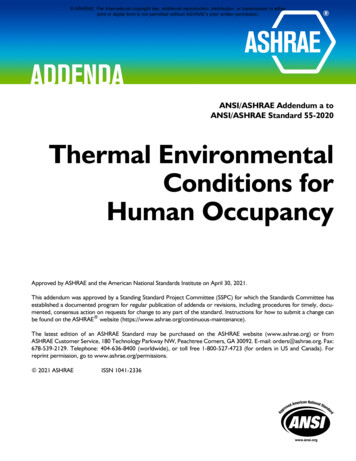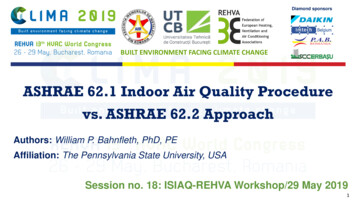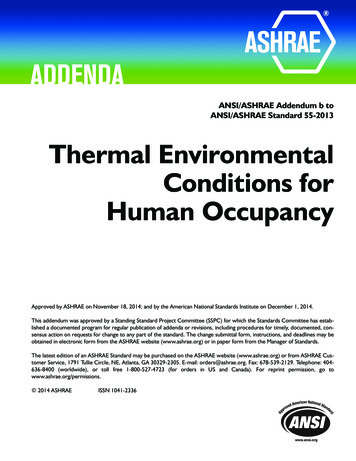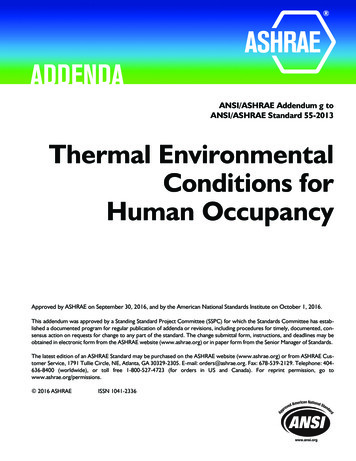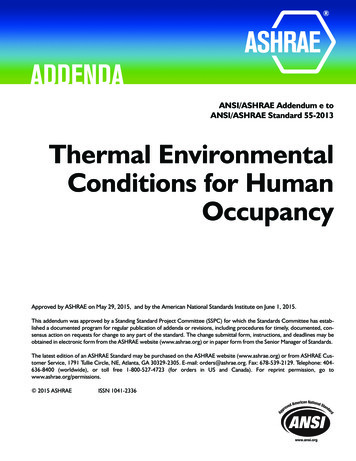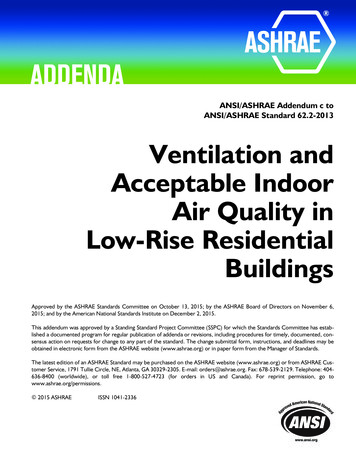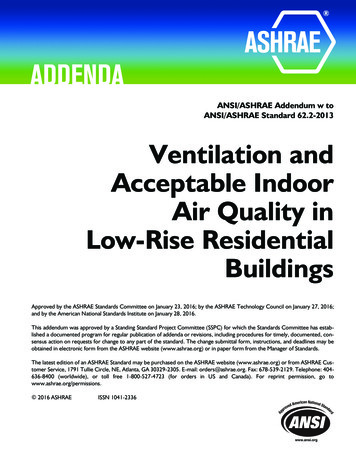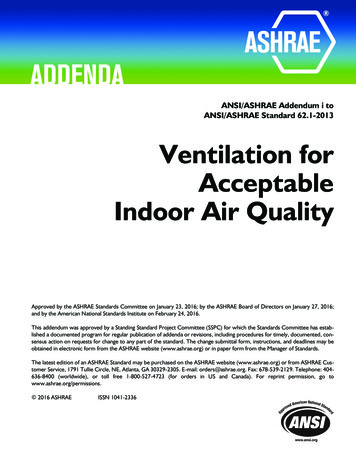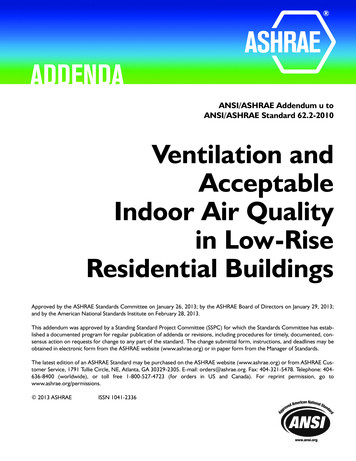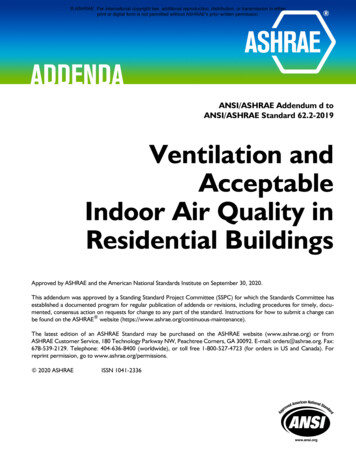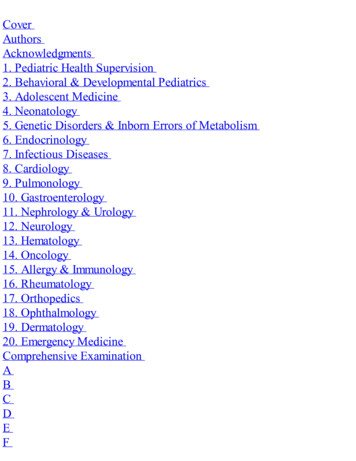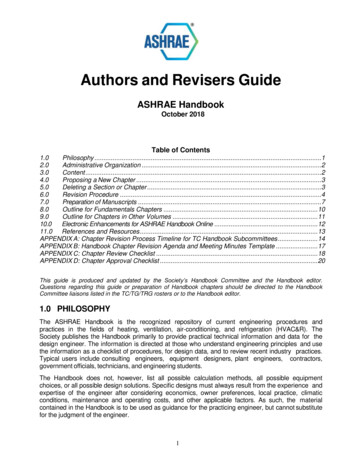
Transcription
Authors and Revisers GuideASHRAE HandbookOctober 2018Table of Contents1.0Philosophy .12.0Administrative Organization .23.0Content .24.0Proposing a New Chapter .35.0Deleting a Section or Chapter .36.0Revision Procedure .47.0Preparation of Manuscripts .78.0Outline for Fundamentals Chapters . 109.0Outline for Chapters in Other Volumes . 1110.0Electronic Enhancements for ASHRAE Handbook Online . 1211.0 References and Resources . 13APPENDIX A: Chapter Revision Process Timeline for TC Handbook Subcommittees . 14APPENDIX B: Handbook Chapter Revision Agenda and Meeting Minutes Template . 17APPENDIX C: Chapter Review Checklist . 18APPENDIX D: Chapter Approval Checklist . 20This guide is produced and updated by the Society’s Handbook Committee and the Handbook editor.Questions regarding this guide or preparation of Handbook chapters should be directed to the HandbookCommittee liaisons listed in the TC/TG/TRG rosters or to the Handbook editor.1.0 PHILOSOPHYThe ASHRAE Handbook is the recognized repository of current engineering procedures andpractices in the fields of heating, ventilation, air-conditioning, and refrigeration (HVAC&R). TheSociety publishes the Handbook primarily to provide practical technical information and data for thedesign engineer. The information is directed at those who understand engineering principles and usethe information as a checklist of procedures, for design data, and to review recent industry practices.Typical users include consulting engineers, equipment designers, plant engineers, contractors,government officials, technicians, and engineering students.The Handbook does not, however, list all possible calculation methods, all possible equipmentchoices, or all possible design solutions. Specific designs must always result from the experience andexpertise of the engineer after considering economics, owner preferences, local practice, climaticconditions, maintenance and operating costs, and other applicable factors. As such, the materialcontained in the Handbook is to be used as guidance for the practicing engineer, but cannot substitutefor the judgment of the engineer.1
1.1CommercialismThe ASHRAE Handbook’s scope includes all aspects of HVAC&R technology. Therefore, differingtechnologies are to be presented accurately in the Handbook and in accordance with the Society’scommercialism policy. Material prepared for publication in the Handbook must be written and criticallyreviewed by the responsible Technical Committee (TC), Task Group (TG), or Technical ResourceGroup (TRG) to ensure that it is free of bias.2.0 ADMINISTRATIVE ORGANIZATIONMany groups and individuals within ASHRAE participate in the Handbook’s production. Thefollowing is the division of responsibilities; for further information, read each group’s Rules of the Board(ROBs) and Manual of Procedures (MOP):Publishing and Education Council—policy, publishing decisions, financial mattersHandbook editor and staff—preparation and publication of the Handbook Editor: Heather E. Kennedy (email: hkennedy@ashrae.org) Editorial assistant: Hayden Spiess (email: hspiess@ashrae.org)Handbook Committee—policy, publishing decisions, chapter assignments, scheduling, coordination,communications Chair Volume subcommittees (4) Subcommittee chairs Members/liaisons to technical committees, listed on TC/TG/TRG rostersTCs/TGs/TRGs—prepare and revise chapters Handbook subcommittee Subcommittee chair Chapter reviewers Chapter lead author/reviser and other authors/revisers3.0 CONTENTThe ASHRAE Handbook includes four separate printed and electronic volumes, currently entitledFundamentals, Refrigeration, HVAC Applications, and HVAC Systems and Equipment. Onevolume is published each year in two editions, one using Inch-Pound (I-P) units of measurement andthe other using the International System of Units (SI). Each print volume includes a CD-ROM containingits contents in both I-P and SI units. A web-based edition, ASHRAE Handbook Online, contains all fourvolumes in both I-P and SI units; its upgraded version, ASHRAE Handbook Online, adds interactiveand supplemental content. The volume sequence is as follows:3.1FundamentalsFundamentals chapters provide concise descriptions of basic engineering principles used in theHVAC&R industry. Lengthy derivations should not be included except by reference. Chapters shouldaddress current design information useful to practicing engineers. They address principles ofoperation and the effect of design parameter changes.Fundamentals chapters may also provide basic data used in HVAC&R calculations and processes.Tables and graphs are available for design engineers. The Fundamentals volume is also often usedas a reference in HVAC&R engineering courses.3.2RefrigerationRefrigeration chapters cover the various types of equipment and systems used in low- andmedium-temperature applications in the food industry, the process industry, and in industrialfacilities. They do not typically cover human thermal-comfort applications.2
Refrigeration chapters may also include basic data such as properties of foodstuffs, and calculationsparticular to the refrigeration industry. Such information would not normally be found in one of the othervolumes, although references to common procedures that appear elsewhere in the Handbook shouldbe used whenever applicable.3.3HVAC ApplicationsApplications chapters provide information to help design engineers use the equipment andsystems described in the other volumes. Applications chapters describe how equipment should beused and what to consider when designing for the application being described. This information helpssystem designers select and use equipment properly. It does not describe how to design componentsor equipment.3.4HVAC Systems and EquipmentSystem-oriented chapters cover various HVAC systems and illustrate the systems’ features anddifferences. They refer to other chapters or volumes for basic design procedures.Equipment-oriented sections or chapters cover components or assemblies. The information helpssystem designers select and others to operate equipment. It does not describe how to designcomponents.4.0 PROPOSING A NEW CHAPTERBefore writing a new chapter, the potential lead author should review existing and previousvolumes’ chapters for duplicate material. Determine if any other chapters or sections should be movedto the proposed chapter. Then prepare a one-page chapter proposal that includes key information,such as the chapter title, potential Handbook volume, proposer’s name, potential coauthors andreviewers, justification, and an outline. Next, identify the most relevant TC for the topic and presentthe proposal to its Handbook subcommittee, and if approved, to the full TC. If approved by the TC,forward the proposal to the Handbook Committee liaison for that TC (if the TC has no liaison assigned,the proposal can be sent to the Society Handbook Committee chair and/or the staff Handbook editor).The liaison will then present the idea to the full Handbook Committee, but the proposer may beasked to assist in the presentation and to answer questions. The liaison will then give the proposerand the TC guidance on whether to proceed with writing the chapter, and when and in which volumethe potential chapter will likely appear.After obtaining the Society Handbook Committee’s (HBC) approval of the proposal, write thechapter. The full manuscript then requires a detailed review, editing, and recorded approval votesby the TC Handbook subcommittee and the full TC. The completed manuscript and supportingmaterial are then sent to the TC’s liaison, who reviews it and either approves or sends it back to theTC for revision. If approved, the liaison sends the manuscript to the Handbook editor for preparationand publication. Be sure to follow the other relevant parts of this guide and observe deadlines to makeapproval and publication of the new chapter as swift as possible.5.0 DELETING A SECTION OR CHAPTERMaterial that is still relevant, even if only important to a small segment of the Society, shouldcontinue to appear in the Handbook. However, because the Handbook is a lasting reference,republishing obsolete information is unnecessary. Instead, refer readers to older volumes of theHandbook. If some material is deemed important but not appropriate, or is too voluminous for theHandbook, consider preparing a separate ASHRAE special publication or ASHRAE Handbook Onlinefeature where readers can find the information.Chapter sections may be deleted through the normal revision process. But to delete an entire chapter,have a recorded vote in the responsible TC’s Handbook subcommittee and then the full TC. Next,forward the recommendation to the Society’s Handbook Committee via the TC’s Handbook liaison.3
6.0 REVISION PROCEDUREReviewers and revisers of Handbook chapters establish the scope of chapters and organize thematerial. Working with the appropriate TCs, TGs, or TRGs, they develop the philosophy andcontent of individual chapters following the outlines presented in Sections 8 and 9 of this guide. It isimportant to follow these outlines for consistency and ease of use by the reader.Although the Society Handbook Committee is responsible for the publication and editorial policy of theHandbook, TCs, TGs, and TRGs write, review, and revise the chapters. Their Manual of Proceduresstates:“Each TC/TG/TRG is charged with the responsibility of preparing and reviewingHandbook chapters within its field of interest and making appropriate recommendationsto the Handbook Committee. The TC/TG/TRG is responsible for the technical contentof these chapters, but review and revision must be coordinated with the publicationschedule established by the Handbook Committee.” (Para. 3.2.1)It is the responsibility of every TC/TG/TRG member to participate in the review of chapters.TCs/TGs/TRGs should devote significant meeting time to discussing the purpose, content, andrevision of their chapters. The Handbook Committee liaison can assist in finding individuals or groupsto write and revise chapters. The liaison works with the revising subcommittee to transmit comments,criticism, and suggestions so that the chapter, when complete, reflects current practice. HandbookCommittee liaisons also provide the connection between the revising TC/TG/TRG subcommittee andthe editor, and are charged with ensuring that the approved chapters are submitted according toschedule.6.1Typical Four-Year Revision ScheduleEach chapter must be given a detailed review and have necessary revisions made at least every fouryears. In addition, updates can be made at any time for inclusion in ASHRAE Handbook Online.See Appendices A and B of this guide for sample templates of a chapter revision scheduleand meeting agendas/minutes. The following is a summary of a typical four-year revisionschedule. Each year is July 1 to June 30:End of Year 0: The chapter is published in the printed Handbook volume, the singlevolume CD, and the four-volume ASHRAE Handbook Online.Year 1: The TC/TG/TRG Chair appoints a Handbook subcommittee and its chair. Ameeting time is established and the subcommittee then meets at every ASHRAE Annual andWinter Conference. The subcommittee and others review the just-published chapter andmake recommendations for its revision. A lead author/reviser for the chapter is selected.The Handbook Committee liaisons will identify to each TC those chapters that have beendetermined to be of concern regarding their revision status.Year 2: The lead author/reviser and others revise the chapter.Year 3: The nearly-complete draft is reviewed by all members of the subcommittee, andthen all members of the TC. After any changes are made, the subcommittee chairrequests a recorded approval vote by the full TC. When approved, the lead author/revisercompletes the chapter approval checklist and submits the revision and supporting materialto the TC’s assigned Handbook Committee liaison before the required deadline.Year 4: The Handbook editor and staff prepare the chapter for publication and send aproof to the TC’s designated final reviewer. After final corrections are made and queriesanswered, the chapter is complete. At the end of the fourth year, the revision is published andthe process begins anew.4
6.2Chapter ReviewFor each chapter, the TC Handbook subcommittee chair selects one or more reviewers to check for errors that should be noted in the errata published with the next volume and on theASHRAE web site (www.ashrae.org), and corrected in ASHRAE Handbook Online;recommend whether the chapter should be discontinued, what revisions should be made, orif no changes are necessary; andsuggest reviser(s) for the chapter.A ch
A web-based edition, ASHRAE Handbook Online, contains all four volumes in both I-P and SI units; its upgraded version, ASHRAE Handbook Online, adds interactive and supplemental content. The volume sequence is as follows: 3.1 Fundamentals Fundamentals chapters provide concise descriptions of basic engineering principles used in the HVAC&R industry. Lengthy derivations should not be included .

